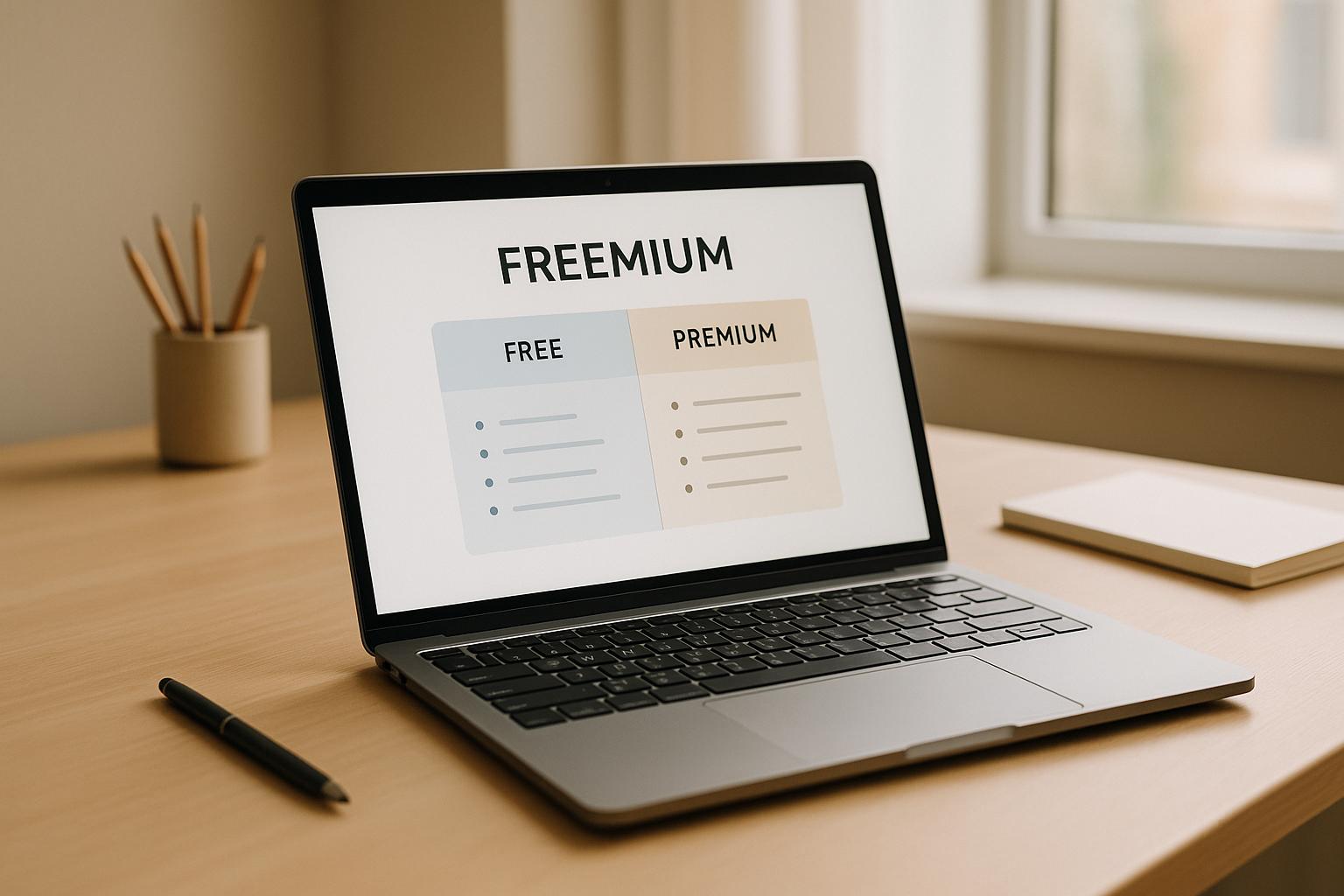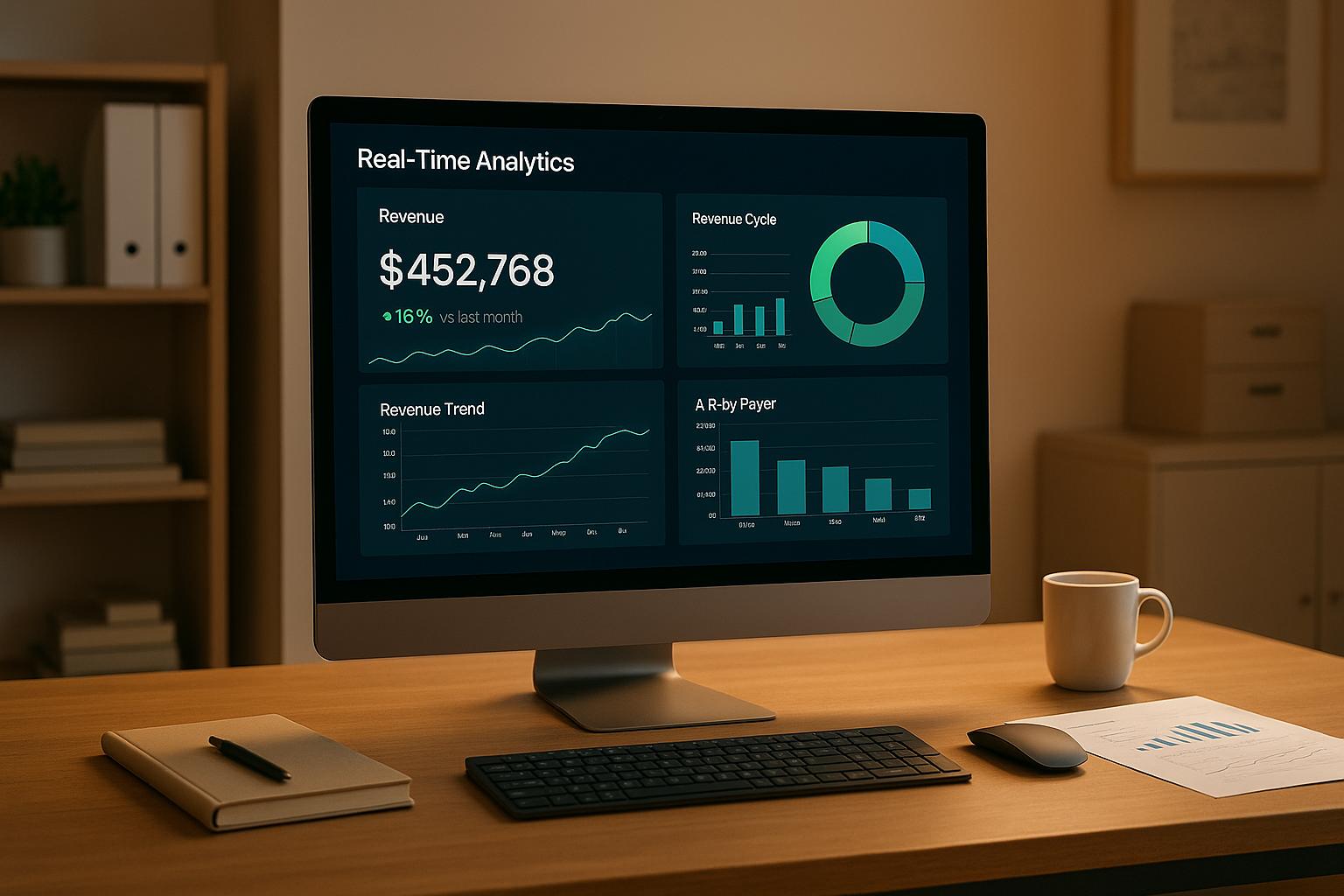How Freemium Impacts Customer Acquisition Costs

Freemium pricing can lower customer acquisition costs (CAC) by using free product access to attract users and drive organic growth. This model shifts focus from expensive sales efforts to product-led strategies, allowing users to explore the product independently and encouraging upgrades through usage limits or premium features. However, freemium comes with challenges like low conversion rates and higher infrastructure costs, which can inflate CAC if not managed effectively.
Key Takeaways:
- Lower CAC: Freemium reduces reliance on large marketing budgets and sales teams by letting the product sell itself.
- Organic Growth: Free users often spread the word, leading to cost-effective referrals.
- Challenges: Supporting free users adds operational costs, and low upgrade rates can strain profitability.
- Optimization Tips: Use feature limits, track user behavior, and personalize upgrade prompts to improve conversions.
Freemium works best when you balance free offerings with clear incentives to upgrade, ensuring growth without overspending on acquisition.
How Freemium Reduces Customer Acquisition Costs
Freemium models offer a smart way to lower customer acquisition costs (CAC), especially for companies aiming to grow quickly without breaking the bank. By shifting away from expensive outbound sales tactics to more efficient, product-focused strategies, freemium creates opportunities to scale while keeping costs in check. Here’s how self-service onboarding, organic referrals, and data-driven marketing play a role in cutting CAC.
Self-Service Onboarding Saves Money
Freemium models naturally reduce upfront acquisition costs, and self-service onboarding takes things a step further. Traditional sales processes often require a large team to guide potential customers through demos, product walkthroughs, and training sessions. With freemium, users can explore the product on their own, eliminating much of this overhead.
This not only reduces payroll costs but also streamlines operations. Instead of spending weeks nurturing leads through a lengthy sales funnel, freemium users can start using the product and finding value almost immediately. This approach is especially effective for software companies targeting small and medium-sized businesses, where the cost of traditional enterprise-level sales methods can be a dealbreaker.
Free Users Spark Organic Growth
One of the biggest advantages of freemium is how free users become unofficial brand ambassadors. When they have a positive experience, they naturally share it with colleagues, friends, and their professional networks. This word-of-mouth effect can dramatically reduce the need for costly advertising and large-scale marketing campaigns.
In the world of business software, the network effect is particularly powerful. For example, when one team member adopts a freemium tool and finds it useful, they often recommend it to others in their organization. This creates a ripple effect where a single free user can lead to multiple paid conversions - all without additional marketing spend.
Viral referrals also reduce reliance on paid channels, making acquisition efforts more efficient and less expensive.
Data-Driven Marketing Boosts Efficiency
Freemium models generate a wealth of user data, which can be a goldmine for refining marketing strategies and improving conversion rates. By analyzing how users interact with the product, companies can design campaigns that target the right audience with the right message.
For instance, behavioral data can reveal which features users engage with most and what prompts them to upgrade. This insight allows marketers to fine-tune their messaging and focus on high-intent prospects, ensuring that every marketing dollar is spent wisely.
Additionally, this data helps identify underperforming channels, enabling companies to shift resources toward those that deliver better results. Over time, this continuous optimization creates a compounding effect, lowering CAC while driving better overall performance. In short, freemium models don’t just reduce costs - they make every aspect of customer acquisition smarter and more effective.
Freemium Model Challenges That Can Increase CAC
Freemium models can be a great way to attract users, but they come with their own set of challenges that, if not handled well, can actually push customer acquisition costs (CAC) higher. Supporting free users isn’t free - it requires resources that can weigh heavily on profitability, especially when too few users upgrade to paid plans. Let’s dive into the specific hurdles that can increase CAC.
Low Conversion Rates
One of the biggest issues with freemium models is that most users stick to the free version. Industry data shows that only a small percentage of freemium users convert to paid plans. Meanwhile, every free user still uses resources like server space, bandwidth, customer support, and development time. This means the cost of acquiring and supporting free users ends up being carried by the relatively small group of paying customers, which can inflate CAC.
The problem compounds when conversion rates are low. A larger base of free users doesn’t just mean higher operational costs; it also means you need more paying customers to offset those costs.
Higher Operating Costs
Freemium models can rack up hidden costs quickly, especially as the number of free users scales. These costs often come from infrastructure needs like servers, bandwidth, and data storage.
"Even if they never pay, free users still cost a business money. They use your infrastructure, contact support, and create data records. If your user base grows quickly, so do these invisible costs, and that's especially true if your product has high marginal costs per user. If your conversion rate is low and your infrastructure spend is high, freemium can get expensive fast." - Stripe
Customer support is another area where costs add up. Free users often need just as much help as paying customers, which can stretch support teams thin.
"Supporting a large pool of free users can be expensive: infrastructure, customer support, and operational expenses. Freemium can strain resources, especially for startups or smaller companies." - Webapper
When the user base grows faster than paying conversions, these operational costs can spiral, making it harder to justify the freemium model in the long run.
Finding the Right Balance of Free vs Paid Features
Deciding what to include in the free tier versus what to reserve for paying customers is a tricky balancing act. Offer too much for free, and users may never feel the need to upgrade. Offer too little, and the free tier won’t attract enough users to begin with.
This balance is especially difficult because it often varies between user groups. What works for an individual user might not appeal to a small business or a larger enterprise. On top of that, competitors offering more generous free tiers can make it harder to convince users to upgrade if your free plan feels less appealing.
The key is to constantly analyze user behavior, conversion trends, and market conditions. Adjusting the mix of free and paid features over time can help keep operational costs manageable while encouraging upgrades. By fine-tuning this balance, companies can better control CAC and improve the overall effectiveness of their freemium strategy.
How to Optimize CAC in Freemium Models
Once you've pinpointed the challenges that can inflate customer acquisition costs (CAC) in freemium models, the next step is to implement strategies that strike a balance: driving conversions while keeping expenses in check. The secret lies in creating a smooth journey that encourages users to upgrade to paid plans without overwhelming them - or your support team. Here's how to make it happen.
Use Feature Limits and Usage Caps
Setting clear boundaries for free-tier users is a smart way to encourage upgrades while still delivering a positive experience. The trick is to let users see the value of your product, then introduce meaningful limits that highlight the benefits of paid plans.
- Storage and usage limits are especially effective because they scale with user activity. For instance, Dropbox offers 2GB of free storage, nudging users to upgrade as they approach the limit. This targets active users who are more likely to convert.
- Feature restrictions can also work well when applied thoughtfully. For example, you might allow users to create a limited number of projects for free, giving them a taste of the product’s value before requiring an upgrade.
- Time-based limits add urgency while showcasing value. Offering full access for a set period - like 14 or 30 days - creates a natural incentive to upgrade once the trial ends.
The key is to make these restrictions feel logical. Users should clearly understand why the limits exist and see upgrading as the natural next step.
Target Users with Personalized Upgrade Offers
Once your limits are in place, the next step is to craft upgrade prompts that feel relevant and well-timed. Generic messages often fall flat, but personalized offers based on user behavior can make a big difference.
- Behavioral triggers are a powerful tool. When users hit a limit or heavily engage with a feature, it’s the perfect moment to present a tailored upgrade offer. Timing is critical - catching users right when they feel the pinch of the free tier can significantly boost conversions.
- Segmented messaging allows you to cater to different user types. A solo freelancer and a small business team have distinct needs. Your upgrade offers should reflect these differences, highlighting features and pricing tiers that resonate with each segment.
- Progressive disclosure works better than overwhelming users with a flood of premium features all at once. Start by promoting the specific feature they just tried to use, then introduce other premium perks gradually as they continue to engage.
Even something as simple as an email triggered by user actions - like exporting data multiple times in a week - can be highly effective. It’s a clear signal that they’re finding value in your product, making it the perfect time to suggest an upgrade.
Track Key Performance Metrics
To keep your freemium model on track, it’s essential to monitor the right metrics. These insights help you refine your approach, ensuring that your pricing, features, and acquisition strategies are hitting the mark.
- Conversion rate by user segment helps identify your most valuable users. For example, tracking enterprise users versus individuals can reveal where to focus your acquisition efforts and how to tailor your messaging.
- Time to conversion sheds light on your sales cycle. Users who upgrade within 30 days might respond to different triggers than those who take six months. Understanding this timeline allows you to fine-tune your nurturing campaigns and set realistic CAC payback expectations.
- Feature usage patterns among converting users highlight what drives upgrades. If most users who upgrade rely on a specific feature set, you can prioritize showcasing those features to new free users and decide which ones belong in the paid tier.
- Cohort analysis reveals trends over time. For instance, if March’s user cohort converts at a lower rate than February’s, you can investigate whether product updates, marketing efforts, or external factors played a role.
sbb-itb-e766981
Key Metrics and Benchmarks for Freemium Success
Keeping tabs on the right metrics is essential for figuring out if your freemium model is truly cutting customer acquisition costs or if it’s hiding potential pitfalls. Data-driven decisions take the guesswork out of the equation, helping you fine-tune your freemium strategy. Below are some of the most important metrics to monitor.
CAC Payback Period
The CAC (Customer Acquisition Cost) payback period tells you how long it takes to recover the money spent on acquiring a customer. This calculation includes revenue from paying customers and the costs tied to supporting free users. By tracking this metric, you can see if improvements in your conversion funnel or onboarding process are effectively shortening the time it takes to break even.
To calculate it, simply divide your customer acquisition cost by the monthly recurring revenue (MRR) per customer. This gives you a straightforward view of how quickly your investment is paying off and highlights areas where marketing or support strategies might need adjustment.
Conversion Rates and User Churn
Conversion rates from free users to paying customers can vary widely depending on your industry and product. Instead of chasing a universal benchmark, focus on understanding how different user segments behave. For instance, early adopters might upgrade quickly when they hit usage limits, while others may need more time to see the product’s full value.
Churn is another critical area to watch. In freemium models, churn happens in two key groups: free users and paying customers. A high churn rate among free users is generally acceptable as long as the cost to serve them remains low. However, churn among paying customers is a direct hit to your long-term revenue and needs to be minimized. Analyzing both types of churn can help you fine-tune your conversion process and retention strategies.
LTV:CAC Ratio
The LTV:CAC ratio (Lifetime Value to Customer Acquisition Cost) is a key indicator of whether your freemium model is sustainable in the long run. A healthy ratio means the revenue earned from a customer far outweighs the cost of acquiring them. However, calculating LTV in freemium models can get tricky since customer lifecycles often include gradual upgrades, add-ons, or increased usage over time.
When estimating LTV, make sure to include not just subscription revenue but also any additional income from upgrades or premium features. Regularly reviewing this ratio helps you track how customer value evolves and ensures your freemium strategy remains profitable.
Companies like Phoenix Strategy Group specialize in helping businesses monitor these metrics by setting up tailored tracking systems and financial models. Keeping a close watch on CAC, conversion rates, churn, and the LTV:CAC ratio allows you to make smarter decisions about marketing budgets, product improvements, and pricing strategies.
Using Freemium to Optimize Customer Acquisition Costs
Freemium pricing offers a powerful way to manage customer acquisition costs (CAC), but its success depends on striking the right balance between free features and effective upgrade incentives. Let’s break down how this model works and what steps can help you refine it.
Key Points to Keep in Mind
Freemium models can lower acquisition costs by leveraging self-service onboarding and encouraging organic growth. Here’s how:
- Self-service onboarding: This approach allows users to explore your product without direct sales involvement. As your user base grows, this method scales efficiently, keeping costs per user manageable.
- Viral growth: Freemium users often introduce your product to their colleagues or networks, creating organic growth that reduces the need for costly advertising.
However, the freemium model isn’t without its challenges. Success requires clear feature boundaries - your free tier must deliver real value while encouraging upgrades through usage limits or premium features.
Most importantly, conversion optimization is essential. Since upgrades drive revenue, even small improvements in conversion rates can significantly impact your bottom line. Dig into what motivates users to upgrade and create more opportunities for those "aha moments" when they see the value of moving to a paid plan.
Next Steps for Scaling Freemium
If you’re looking to refine or implement a freemium strategy, start by understanding your unit economics. This means assessing the costs of supporting free users and ensuring that upgrade conversions offset those costs.
- Model your unit economics: Calculate the expenses tied to free users, such as server costs, customer support, and development resources. Then, determine the conversion rate needed to achieve profitability - and whether that target is realistic for your market.
- Set up tracking systems: Visibility into user behavior is critical. Track metrics like feature usage, conversion funnels, and upgrade triggers to make informed decisions about pricing and product development.
- Consider when to launch freemium: Timing matters. If you’re a resource-constrained startup, you might start with a paid-only model to validate product-market fit and generate revenue. Once your foundation is solid, freemium can help scale your growth.
- Test feature limits: Don’t assume you know the perfect split between free and paid features. Experiment with different configurations to find the balance that maximizes both user satisfaction and conversion rates.
For growing companies, working with financial experts can provide valuable insights into pricing strategies and unit economics. For example, Phoenix Strategy Group specializes in helping businesses analyze financial impacts, set up tracking systems, and evaluate whether freemium aligns with their growth stage and business goals. Their expertise can be a game-changer when fine-tuning your approach.
FAQs
How can businesses control the costs of supporting free users in a freemium model?
To keep expenses in check while supporting free users in a freemium model, businesses should craft free tiers that deliver value without overburdening resources. The key is to offer essential features that highlight the product's strengths without stretching operational capacity too thin.
Another smart approach is to adopt tiered pricing or usage-based models. These strategies gently nudge free users to upgrade as their usage or needs increase. By tying resource consumption to revenue opportunities, companies can strike a sustainable balance between serving free users and ensuring profitability.
How can companies increase the number of free users who upgrade to paid plans in a freemium pricing model?
To increase the number of free users upgrading to paid plans in a freemium model, it’s crucial to offer an onboarding process that’s smooth and gets straight to the point. By quickly showcasing the most important benefits, users are more likely to grasp the value of upgrading. Tailoring the experience to individual users and clearly presenting the perks of the paid version during the free period can make a big difference.
Adding a sense of urgency - like limited-time discounts or exclusive features - can nudge users toward upgrading. On top of that, actively collecting user feedback and using it to fine-tune the product ensures a better experience, which can lead to steady growth in conversions.
What is the impact of the freemium model on a business's long-term profitability and growth?
The freemium model has the potential to fuel long-term growth while keeping customer acquisition costs (CAC) in check. By offering a free tier, businesses can attract a larger audience, creating a steady stream of users who may eventually transition into paying customers. Over time, this approach can significantly increase revenue.
The key to making this model work lies in balancing what’s free and what’s premium. The free features should be appealing enough to draw users in but not so comprehensive that they eliminate the need to upgrade. At the same time, the lifetime value (LTV) of paying customers must outweigh the CAC to maintain profitability. Missteps, like relying too heavily on free users or underestimating the difficulty of converting them, can undermine the model’s effectiveness. With thoughtful execution, the freemium approach can pave the way for scalable and sustainable growth.




